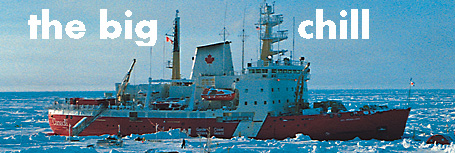

Leads are one of the major Arctic phenomena scientists want to measure (everyone just wishes they weren't opening and closing through the heart of the station all the time). Openings in the ice that expose the ocean trigger all kinds of reactions that SHEBA researchers need to document to improve climate models. For example, open water:
Reflects only 10 percent of the sun's radiation compared to snow and ice (60 percent or more). Measuring the albedo--the amount of radiation a particular surface reflects--is an important factor in studying melts and refreezes. As ice melts and turns to water, the albedo is reduced. The water surface absorbs more sunlight, the ice it touches melts faster, so even more sunlight is absorbed. It might be sunny for many days in a row, and there will be far more warming and melting if there are numerous melt ponds and leads than if the pack is frozen solid with snow on top.
Gives off heat. Although the water is only slightly above freezing, it is still much warmer than the ice pack and atmosphere above. Before the openings between floes refreeze, water vapor can cause fog or a rainbow to form near the ice surface. The vapor can trigger the creation of clouds. Scientist want to know if the resulting cloudiness keeps sunlight from reaching the surface and slows warming, or do the clouds trap warmth and enhance melting?

Though it can be as cold as -45F outside, the interior of the research huts must stay warm enough to run computers and equipment. Seen here are (left to right) Miles McPhee of McPhee Research, Tom Lehman of the UW Applied Physics Lab, and Tim Stanton of the Naval Postgraduate School in Monterey, Calif. Photos by Sandra Hines and Andries Blouw.
Gathering data at SHEBA to unravel these and other climate-model puzzles has involved a submarine prowling beneath the ice cap as well as six orbiting satellites and four different kinds of research aircraft passing overhead. At the station, instruments hang from tethered balloons and are mounted on three different metal towers, the ship deck and on the ice.
Used for the first time to take measurements under the ice pack is a 5-foot-long, torpedo-shaped vehicle prepared by oceanographer Jamie Morison and his colleagues at the Applied Physics Laboratory. Programmed to travel underwater and return to its starting point, the vehicle collects information about how ocean currents and other forces mix newly melted water with sea water. Much of this mixing happens within the top 30 to 40 feet of the ocean surface and may happen at different rates depending on whether the water is in an open lead or under thick ice, Morison says.
While the research continues and will take years to digest, some results are already being published. Miles McPhee, an oceanographer from Naches, Wash.; Morison and his son, David; and others found the water much warmer and fresher than measurements made in the same area about 20 years ago.
The findings were significant enough to be published by the American Geophysical Union. Polar scientists think that changes in the atmosphere over the region since the late '80s may be triggering changes in the ice pack. SHEBA ocean measurements appear to correspond to what has happened to the ice, Morison says.
Are we discerning a previously unknown natural climate cycle? Is the change human-made or being enhanced by our actions? Is it inevitable?
It is sobering to think about the consequences if the ice pack should disappear during the summer or year-round.
As Morison says, "My son is in college. Even though the changes we've documented may not prove to be long-term, I can't help wondering if he'll see an ice-free Arctic in his lifetime. Maybe one day he'll tell his disbelieving grandchildren about how he visited the Arctic when there was still ice there."
Sandra Hines, assistant director of the UW's News and Information Office, visited SHEBA in March.
Return to the Beginning of "The Big Chill"
Send a letter to the editor at columns@u.washington.edu.